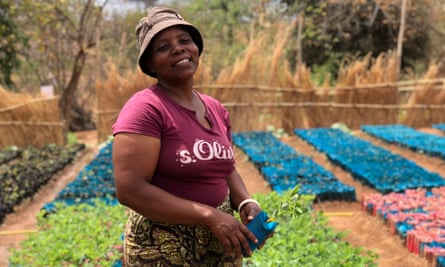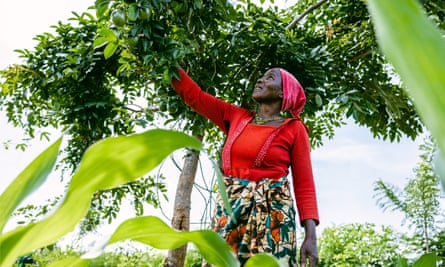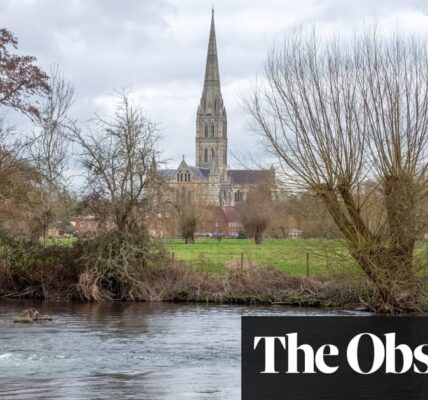The African initiative for planting trees that is seven times larger than Manhattan is having a significant impact.
An African project is challenging the norm of monoculture cash crops by encouraging farmers to cultivate biodiverse forest gardens. These gardens not only provide food for families but also protect the soil and promote tree growth.
Is Trees for the Future (TREES) a unique instance of a large-scale reforestation initiative that is successful? The United Nations Environment Programme (UNEP) appears to believe so, as it recently designated it as a World Restoration Flagship.
Since its establishment in 2015, the initiative has annually planted tens of millions of trees in nine different countries, including Senegal, Mali, Tanzania, and Kenya. In just under a decade, it has successfully regenerated approximately 41,000 hectares of land, equivalent to about seven times the size of Manhattan.
This includes part of the African Union’s Great Green Wall initiative, a planned 8,000km-wide barrier of vegetation to hold back the deserts that are encroaching across the Sahel region. Organisers say this will be the largest natural structure on the planet, though it is still very much a work in progress.

The organization Trees for the Future has bold objectives to address poverty through reforestation efforts. By the year 2030, it seeks to establish 230,000 job opportunities and plant one billion trees.
Inger Andersen, executive director of UNEP, emphasizes the importance of dedicating efforts to restore Africa’s land. It is no longer sufficient to only preserve what remains of its fertile soil. With a quarter of the world’s population projected to live on this continent in the next few decades, many regions have already experienced degradation and turned into semi-barren arid areas.
“The World Restoration Flagship was announced by Andersen, acknowledging the crucial impact of initiatives such as TREES in countering years of deterioration in ecosystems, particularly in the Sahel region. These efforts have successfully fought against desertification, enhanced resilience to climate change, and brought about positive changes in the lives of farmers and their communities.”
Although reforestation is indisputably necessary, there is past evidence that may lead to doubts about the success of these initiatives. Ambitions for reforestation may be overly optimistic. A recent study in 2019 proposed that planting a trillion trees worldwide could greatly alleviate the climate crisis, but it was later discredited as impractical due to inadequate available land.
Several governments have implemented large-scale efforts to plant trees, but after the initial media attention dies down, there is often inadequate irrigation, protection, and follow-up to guarantee the growth of seeds and saplings into full-grown trees. These national campaigns are frequently seen as mere attempts to appear environmentally friendly, diverting attention from extensive deforestation happening in other areas.
One instance is Kenya, which has implemented multiple projects to plant trees in the last few years, such as the Million Operation Gavisha in 1977, the Trees Campaign in 2006, the Greening Kenya Initiative in 2010, and the Accelerated National Tree Growing Campaign 2022. Despite these efforts, Kenya’s tree cover has still decreased by 11% since 2000.
The state of affairs has improved to some extent in the previous two years during the term of the current president, William Ruto. He has instituted an annual holiday for tree-planting and established a national goal to plant 15 billion trees and increase tree coverage to 30% by 2032. However, these advancements may not last long as Ruto recently lifted the six-year ban on logging in order to stimulate economic growth. This puts additional strain on the already-threatened Mau forest, which is being cleared for tea and wheat cultivation; Migori forest, which is facing encroachment from sugar producers; and Nyanza forest, which is expanding for use by tobacco farmers.
Preserving natural forests is crucial for mitigating climate change, protecting native species, and maintaining local water systems. These vital functions, formed over centuries, cannot be entirely substituted by newly established plantations and restoration efforts. However, initiatives such as TREES can assist in addressing ecological and economic issues in previously damaged regions.
Ignore the advertisement for the newsletter.
after newsletter promotion

In western Kenya near Lake Victoria, Kesouma has assisted 17,000 small-scale farmers by providing education, seeds, equipment, and funds for them to cultivate “forest gardens” instead of relying on single crop farming, which has previously left their land vulnerable and depleted of essential resources such as moisture, carbon, and nutrients.
The region is divided into clusters of 20 individual farmers, each led by a representative farmer. These lead farmers receive a monthly payment of 3,000 Kenyan shillings. All members gather frequently for updates, education, and use of resources such as tools and seed banks to maintain their forest garden. On average, each farmer has a plot of 1 hectare, with around 5,800 trees of different types.
The area surrounding the center contains a barrier consisting of three layers of Acacia polyacantha (white thorn) for protection. Behind this barrier lies a group of densely planted agroforestry trees that have a rapid growth rate and can serve as a source of firewood and food for livestock. In the middle of this setup, there is a combination of vegetable patches and orchards growing mangoes, avocados, oranges, apples, and other fruits. The main goal is to produce enough nutritious food to sustain a family, with the potential to sell any excess crops at a local market.
In one pilot area in the Lake Victoria basin, incomes are to be further bolstered by cash from carbon credits provided by the US firm Catona Climate based on gains in soil organic carbon, which is measured by experts from the University of Nairobi and Wangari Maathai Institute of Peace and Environmental Studies.
Monitoring is a key element in any reforestation programme, as is maintenance, particularly in remote areas. Major projects in China and Africa – including the Great Green Wall – have tried to address this by dropping seeds by plane in uninhabited areas. With species often unsuited to the terrain and irrigation impossible, this has often resulted in wasted efforts. In that regard, forest gardens seem more promising, though the scope is limited. Farmers usually live in or near their fields and have a financial incentive to ensure the quality of the soil and the healthy growth of a variety of trees.
The director of TREES in Kenya, Vincent Mainga, stated that with the support of UNEP, the project will experience rapid growth. He explained that the project focuses on regenerative agriculture and is a large-scale restoration effort. Mainga added that the model is easily adaptable and involves a four-year collaboration with farmers. By the end of the four years, the farmers are equipped with the knowledge and skills from our technicians to cultivate productive farmlands and even generate a surplus. The project is sustainable in itself.
Source: theguardian.com



